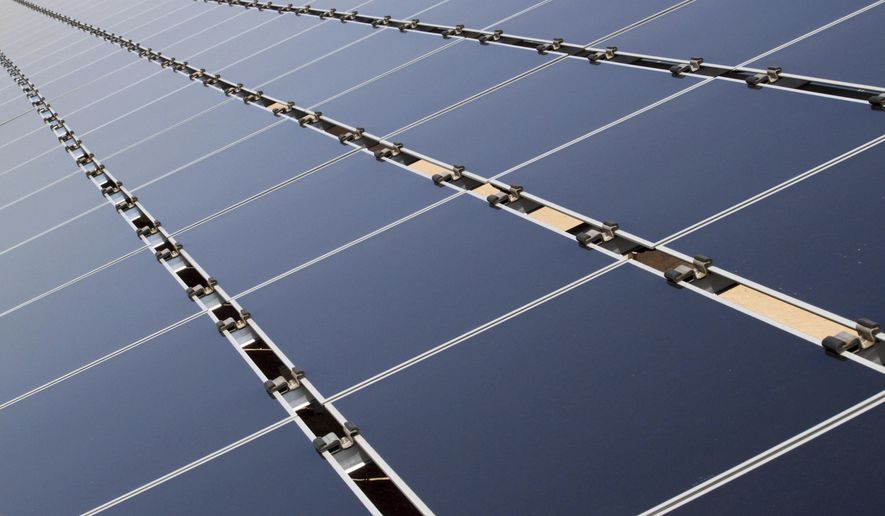Solar proponents are melting down over a Trump administration move to curb the development of a project in Nevada that environmental groups said would threaten the sensitive ecosystem and blight one of the most intact remaining landscapes in the state.
Esmeralda 7 was slated to become the largest solar development in America if the 62,300-acre array is ever completed.
But the Trump administration has thrown up a big obstacle, halting an environmental review that was fast-tracked last year by the Biden administration in its quest to eliminate fossil fuels from the energy grid.
The move caused an uproar in the solar industry, which is grappling with the Trump administration’s clawback of billions of dollars in federal subsidies.
When completed, the massive solar farm would have the capacity to generate 5.35 gigawatts of energy, enough to power about 1.6 million homes. Now its future is uncertain, industry experts said.
“While we await further clarity from BLM on its apparent decision to abruptly cancel these solar projects in the late stages of the review process, we remain deeply concerned that this administration continues to flout the law to the detriment of consumers, the grid, and America’s economic competitiveness,” said Ben Norris, vice president of regulatory affairs for the Solar Energy Industries Association.
“We need more power on the grid, fast, and the solar and storage industry is ready to provide it, but we need the administration to get serious about truly achieving American energy dominance,” he said.
The project encompasses seven adjacent utility-scale solar facilities on a 118,000-acre footprint of federal land near Tonopah, Nevada, 270 miles northwest of Las Vegas.
Bureau of Land Management officials deny canceling the project but will take a more careful look at it.
Earlier this month, they scrapped the Biden administration’s streamlined plan to greenlight the facility as a single project, a move critics say all but cancels it.
“The projects were initially submitted as a group. Now, the developers will pursue individual applications for their respective projects,” an Interior Department spokesperson told The Washington Times.
“This approach ensures focused, thorough assessments of potential impacts on public lands while supporting responsible energy development. This approach aligns with the Administration’s emphasis on improving permitting efficiency and reducing regulatory burdens,” the official said.
Area environmental groups cheered the decision and said the federal government’s approval of the massive solar farm was rushed under President Biden in his push to advance renewables.
Opponents said the massive project would destroy archaeological sites, disrupt the bighorn sheep habitat and destroy 50,000 acres of vegetation, including rare plants.
“The Biden administration was definitely trying to move solar quickly and for us, seemingly at all costs, without listening to the local communities and others who had concerns about some of the siting issues,” said Shaaron Netherton, executive director of Friends of Nevada Wilderness.
The move reflects President Trump’s effort to pivot the U.S. away from solar and wind projects. He is instead seeking to increase coal, natural gas, and nuclear to secure the electrical grid with more baseload energy.
Mr. Trump called solar and wind projects “the scam of the century,” saying they destroy farmland, harm the environment and raise energy prices.
Grids that incorporate solar and wind require firing up backup energy from coal, nuclear and gas. The process of constantly powering up and winding down energy plants raises the cost of electricity. Offshore wind, one of the most expensive forms of energy, is projected to further hike energy prices if those projects are connected to the grid.
Critics say the move to halt Esmeralda 7 is part of the Trump administration’s broader attack on clean energy.
Mr. Trump has halted most offshore wind projects along the U.S. Eastern Seaboard and killed a 1,000 megawatt wind farm on federal land in Idaho. The Trump administration added additional hurdles for granting federal land leases to solar and wind projects, and his One Big Beautiful Bill budget law phased out billions of dollars in wind and solar tax credits.
Green energy proponents say hobbling the development of wind and solar weakens the grid.
“On one hand, the administration seeks to reduce bureaucracy and unleash energy production. On the other, it increases bureaucratic barriers, undermining domestic energy development and harming American businesses and workers,” said American Clean Power Association President Jason Grumet.
Environmental groups that oppose the Esmeralda 7 project say they support wind, solar and other renewables, but believe the projects should not harm the environment.
“We’re hoping to see more rooftop solar and more solar panels in urban areas, and fewer solar panels in undisturbed habitats on public lands,” said Erik Molvar, executive director of the Western Watersheds Project. “That’s the bottom line.”
• Susan Ferrechio can be reached at sferrechio@washingtontimes.com.




Please read our comment policy before commenting.